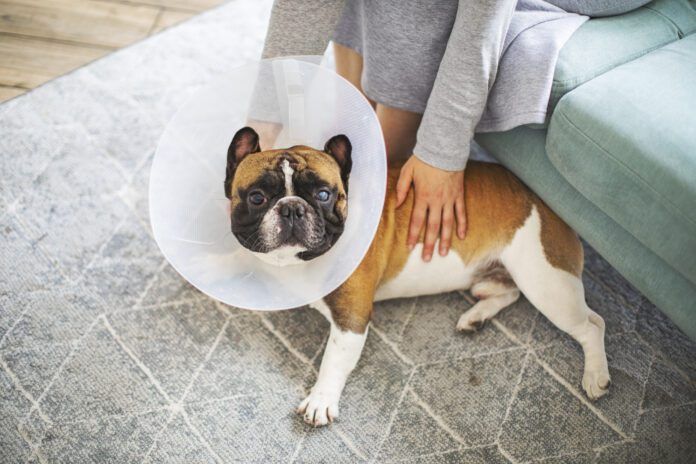Dogs who undergo general anesthesia for a surgical, dental, or diagnostic procedure often receive a combination of drugs during their hospital stay, including sedatives, anxiolytics (anti-anxiety medications), and analgesics (pain medications). They also receive an injectable anesthetic agent to induce anesthesia and a gaseous anesthetic agent to maintain anesthesia once they are anesthetized.
The injectable and gaseous anesthetic agents are metabolized quickly by your dog’s body and are typically out of your dog’s system by the time he returns home. But sedatives and anxiolytics can linger in your dog’s body and the side effects they cause can last 12 to 24 hours. Analgesics are designed to remain active in your dog’s body for 8 to 12 hours after administration to provide pain relief. Analgesics can also have some side effects.
If Your Dog Is Whining After Anesthesia
Whining after returning home from a surgical or dental procedure could be due to your dog feeling a little disoriented or dysphoric. But excessive whining or crying that does not resolve within 30 to 60 minutes of returning home could be an indication that your dog is in pain. Follow your veterinarian’s instructions regarding when and how much to give of your dog’s prescribed pain medications. If your dog continues to whine or starts acting uncomfortable or restless, contact your veterinarian for further instructions.
What to Expect After Anesthesia
Being under anesthesia can slow the forward movement of your dog’s gastrointestinal system, also known as peristalsis. Your dog was also likely fasted at least 12 hours prior to his procedure. An empty stomach, combined with slowed peristalsis, means that your dog may not have a bowel movement until 48 to 72 hours after he comes home. This is normal and expected.
Sedatives and anxiolytics can make dogs sleepy, have an unsteady gait, startle easily, or be disinterested in eating. These effects typically last about 12 to 24 hours after returning home.
Dogs who experience inappetance should not be forced to eat or drink. Your dog will eat and drink when he is ready and feels up to it. He likely received intravenous fluids while he was under anesthesia and therefore may not have a desire to drink water right away.
Keep your dog away from stairs or from places where he might fall. This includes being up on furniture. Once he has recovered from anesthesia, follow your veterinarian’s instructions regarding return to physical activity after a surgical or dental procedure.
Some dogs will startle easily and act in unexpected and unusual ways upon returning home. This can include snapping at loved ones for even the mildest of transgressions. You may want to keep your dog separated from young children and other pets in the home while he recovers.
Your dog may have a slight cough for one to two days after an anesthetic procedure. Most dogs who are anesthetized are intubated to deliver oxygen and anesthetic gas directly to their lungs. Intubation is the placement of an endotracheal tube down the throat and into the trachea. Endotracheal tubes can sometimes cause tracheal irritation, resulting in a mild cough that resolves on its own after a couple of days.
Analgesics are designed to relieve pain for 8 – 12 hours after administration. Some analgesics can make your dog feel sleepy or dilate his pupils. These side effects are typically mild. The benefits of pain relief typically outweigh the mild side effects.
Side Effects After Anesthesia
Dogs who are overweight may experience side effects from sedatives and anxiolytics for longer periods of time than lean dogs. This is because many of the sedatives and anxiolytics used in veterinary medicine are fat-soluble. A fraction of the drugs administered are stored in a dog’s body fat and then slowly re-released into their bloodstream over time. This can lengthen a dog’s complete recovery from anesthesia.
While most of these side effects are expected, there are some that are not. Contact your veterinarian if you notice any of the following signs:
- Vomiting
- Diarrhea
- Not eating or drinking after 12 hours
- Still sleepy after 24 hours
- Still unsteady on his feet after 24 hours
- No bowel movement after 72 hours
- Cough that does not resolve after three days or becomes worse over one to three days
Recovery from anesthesia continues and ends at home. You are the eyes and ears for your dog’s healthcare team while he recovers in your care. Reach out to your veterinarian with any questions or concerns you may have about what you observe during your dog’s recovery period.





